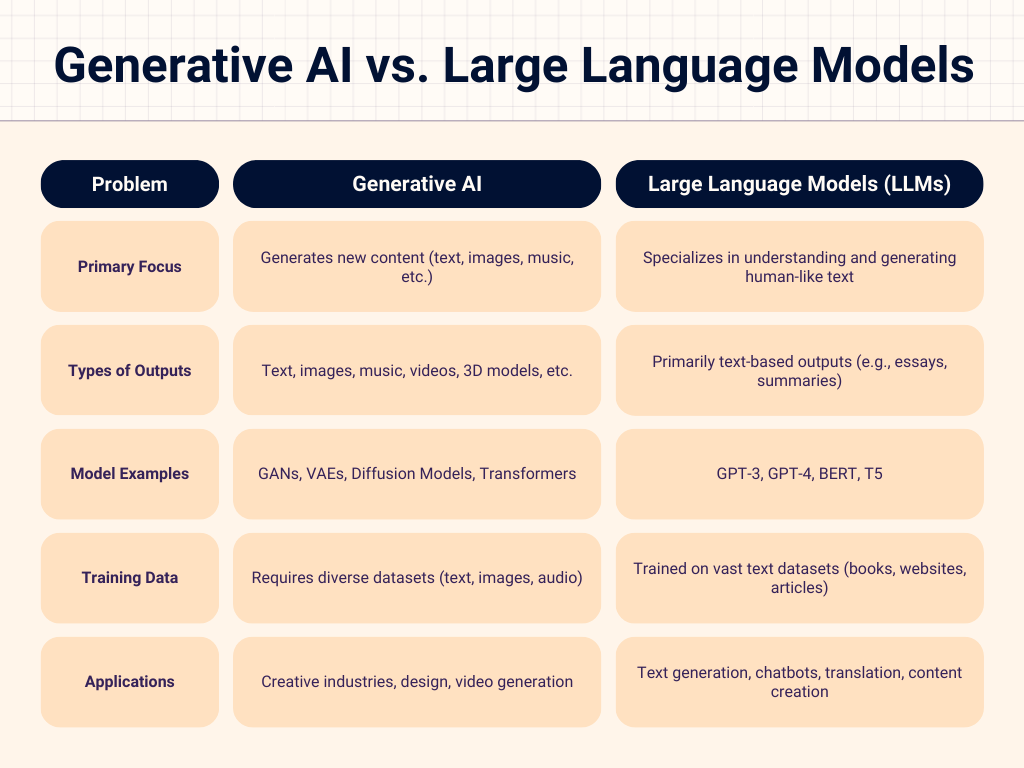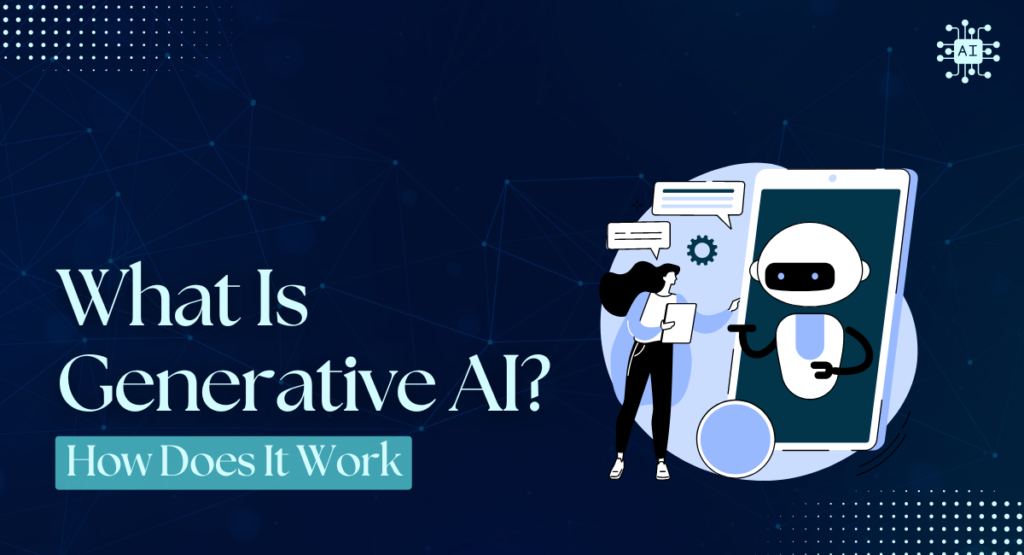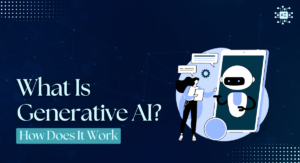Generative AI is transforming industries across the globe by producing human-like text, images, music, and more. It’s not just a buzzword; it’s a powerful tool for reshaping business, technology, and creative processes.
In this guide, we’ll break down the fundamentals of Generative AI, how it works, its types, and its applications while exploring this technology’s challenges, benefits, and future potential.
What is Generative AI?
Generative AI refers to artificial intelligence models capable of generating new content, whether it’s text, images, or even music. Unlike traditional AI models designed to classify or predict, Generative AI creates something entirely new based on patterns and data it has learned.
For instance, tools like OpenAI’s GPT-4 can write essays, and platforms like DALL·E can create visuals based on text descriptions. The fundamental aspect of Generative AI is that it doesn’t replicate—it generates new outputs, which are similar but not identical to the data it has been trained on.
How Generative AI Works: Understanding the Process
Generative AI models use large datasets to learn patterns and relationships in data. Through machine learning and neural networks, these models can generate outputs that mimic human creativity.
Generative AI is powered by machine learning (ML) and deep learning (DL). These technologies enable AI models to learn from extensive datasets and generate outputs that resemble human-created content.
Here’s a simplified breakdown:
- Training Data: Generative AI models are trained on vast amounts of data. For example, a text model like GPT-4 might be trained on billions of words from books, websites, and other sources.
- Neural Networks: These models use neural networks, particularly deep learning architectures, to learn patterns and relationships in the data.
- Probabilistic Modeling: Generative AI models work by predicting the likelihood of the next data point in a sequence. For text, this could mean predicting the next word; for images, it could be the next pixel or feature.
The magic lies in how these systems refine their understanding and produce new, coherent, and sometimes creative outputs.
Understanding the Key Types of Generative AI Models
There are several key types of models used in Generative AI, each with its own purpose and strengths:
- Generative Adversarial Networks (GANs): GANs consist of two neural networks—the generator and the discriminator. The generator creates new data, and the discriminator evaluates it. Through this adversarial process, the generator becomes more skilled at producing realistic outputs.
- Variational Autoencoders (VAEs): VAEs learn to compress input data into a latent space and then decode it back to generate new data that is similar but not identical to the original input.
- Transformers (e.g., GPT models): These models are the backbone of natural language processing (NLP) tasks. They use attention mechanisms to understand context and generate coherent text.
- Diffusion Models: A newer approach in AI, diffusion models work by adding noise to data and learning to remove it, enabling high-quality image generation.
Each model has its use cases, from image generation to producing natural language content, and selecting the right one depends on the application.
Building Generative AI Models: A Complete Guide
Building Generative AI models requires expertise in machine learning and access to high-quality data. Here’s a simplified outline of the development process:
- Define the Objective: Whether you’re building a chatbot or an image generator, the first step is defining what you want the model to achieve.
- Collect and Preprocess Data: The quality of your AI is only as good as the data it is trained on. Collect vast amounts of data that align with your model’s goal. This data must be cleaned and preprocessed before training.
- Select the Right Model: Choose a model that fits your task. For text generation, models like GPT are ideal, while GANs excel in image creation.
- Train the Model: Use high-performance hardware like GPUs or TPUs to train the model. This process involves feeding the data into the neural network and adjusting parameters to minimize errors.
- Evaluate and Fine-Tune: After initial training, you’ll need to test the model and fine-tune it. This step ensures that the model generates high-quality content with minimal errors.
- Deploy and Maintain: Once the model is ready, deploy it into your environment, and continuously monitor its performance. AI models often require updates as they learn and improve with new data.
Real-World Applications of Generative AI You Should Know
Generative AI has broad applications across many industries. Here are some key areas where it’s making a significant impact:
- Content Creation: Text generation tools like GPT-4 help businesses automate writing, whether it’s marketing copy, articles, or even technical documentation.
- Design and Art: Platforms like DALL·E and MidJourney are revolutionizing design, enabling users to create complex visuals from simple text prompts.
- Healthcare: In medical research, Generative AI models are being used to generate molecular structures for drug discovery, accelerating the development of new treatments.
- Gaming and Entertainment: Game developers use AI to generate characters, levels, and even entire narratives dynamically, making gameplay more engaging.
- Personalized Recommendations: AI can generate personalized content, whether it’s movie recommendations or tailored marketing offers, based on user data.
The Best 5 Generative AI Tools to Try Today
Generative AI tools offering advanced content creation and design solutions.
Here are five popular tools driving this change.
1. ChatGPT
ChatGPT, by OpenAI, excels in text generation. It handles tasks like answering questions and drafting emails, making it useful for both individuals and businesses. Its ability to generate relevant, high-quality text makes it essential in areas like customer service and content creation.
2. DALL·E 2
DALL·E 2 creates unique visuals from text descriptions. This tool empowers designers and marketers to generate high-quality images effortlessly, whether for concept art or commercial design.
3. MidJourney
MidJourney specializes in creating artistic images from prompts. Widely used in the creative industry, it allows users to generate visuals in various styles, helping streamline artistic projects.
4. Jasper AI
Jasper AI is built for content marketers. It generates engaging, high-quality copy for blogs, social media, and more, making it essential for businesses looking to enhance their content strategies.
5. Runway ML
Runway ML focuses on video, 3D design, and audio generation. Its integration with creative software makes it a go-to tool for professionals in media and digital content creation.
How Generative AI Adds Value: Key Benefits Explained
Generative AI is changing how industries approach problem-solving and creativity. By using machine learning models that generate content based on data inputs, it enables businesses to streamline operations and elevate user experiences.
Despite its challenges, Generative AI offers several key benefits:
- Automation: It can streamline tasks that traditionally required manual effort, such as content creation or image design, boosting productivity.
- Cost Savings: By automating tasks, Generative AI reduces the need for large teams, resulting in lower operational costs.
- Personalization: AI models can generate personalized recommendations or content tailored to individual users, enhancing the customer experience.
- Creativity Boost: AI serves as a creative partner for designers, writers, and artists, offering new ideas and possibilities that wouldn’t have been considered otherwise.
Generative AI Risks: What You Should Be Aware Of
Generative AI, while showcasing impressive advancements, comes with significant risks that businesses and individuals must understand. These risks span various areas, from ethical concerns to technical challenges.
1. Bias and Ethical Issues
Generative AI models often inherent biases from the datasets they are trained on. This can lead to outputs that reinforce stereotypes or promote harmful narratives. For businesses using generative AI for customer-facing applications, this risk could damage brand reputation and foster mistrust among consumers.
2. Misinformation and Deepfakes
Generative AI can easily create highly realistic content, including deepfakes, which can be used maliciously to spread misinformation. In political, social, or financial contexts, deepfakes can manipulate public opinion or defraud individuals by impersonating trusted figures or creating fake events.
3. Copyright Infringement
Generative AI models often use vast amounts of publicly available content for training, raising concerns about intellectual property violations. The outputs generated may inadvertently replicate copyrighted material, potentially leading to legal disputes for businesses that unknowingly publish or use such content.
4. Security Vulnerabilities
Generative AI tools can be exploited by hackers to craft highly personalized phishing attacks or to create malicious software. This capability increases the risk of cybersecurity breaches for companies and individuals, making it crucial to regulate the use of such technologies.
5. Loss of Human Creativity
As generative AI becomes more prevalent, there is concern that over-reliance on it may stifle human creativity. This can lead to homogenized outputs in industries like art, content creation, and marketing, where originality is a key asset.
6. Over-reliance on Automation
Generative AI tools can automate complex tasks, but over-reliance can lead to skill degradation in the workforce. Workers might become overly dependent on AI-generated solutions, reducing their ability to think critically or solve problems independently.
By understanding these risks, businesses and developers can implement safeguards and develop responsible AI strategies, ensuring they harness the benefits without compromising ethics, security, or creativity.
Generative AI vs. Large Language Models: A Clear Comparison
Generative AI and Large Language Models (LLMs) are often discussed together, but they serve different purposes in the AI ecosystem.

The Future of Generative AI
Generative AI is still in its early stages, but its future is incredibly promising. As models continue to improve, we can expect AI to play a more prominent role in creative industries, healthcare, and business operations.
Additionally, ethical frameworks and regulations will likely emerge to address the challenges and risks associated with this technology.
This blog highlights key trends shaping the future of generative AI.
Content Creation Advancements
Generative AI is becoming essential in content creation, assisting with writing, design, and video production. While it enhances creativity, it raises concerns about authenticity and intellectual property. As these tools evolve, balancing innovation with ethical considerations is vital.
Healthcare Innovations
In healthcare, generative AI aids in drug discovery, medical imaging, and personalized treatments. By analyzing vast datasets, AI improves treatment outcomes. The future holds promising advancements, particularly in precision medicine.
Ethical and Regulatory Concerns
As AI models advance, ethical concerns around bias, fairness, and accountability intensify. Regulatory frameworks must evolve to address these issues, ensuring responsible use. Clear guidelines are essential to prevent AI misuse.
Human-AI Collaboration
Generative AI is a tool for collaboration, not replacement. It automates routine tasks, allowing professionals to focus on complex, creative work. This partnership will drive future innovations in product design, software development, and more.
Conclusion
Generative AI is a transformative technology, impacting content creation, healthcare, and more. While it presents immense potential, understanding its challenges and ethical implications is vital. Responsible use and continuous refinement will shape its role in the future.
FAQs on Generative AI
How is GenAI Different from Traditional AI?
Traditional AI focuses on making decisions based on existing data, while GenAI creates new data or content from the patterns it identifies. It can mimic human creativity, but its outputs are based on its training.
Can GenAI Be Used for Business Applications?
Yes, businesses use GenAI for various applications, including content generation, product design, and customer service automation. It’s especially valuable in industries that rely on high volumes of content creation and data-driven insights.
What Are Some Examples of GenAI in Use Today?
Common applications include text generation for marketing, AI art creation, and automated coding assistance. Tools like GPT models can write content, while others design visuals or automate tasks in software development.


